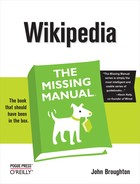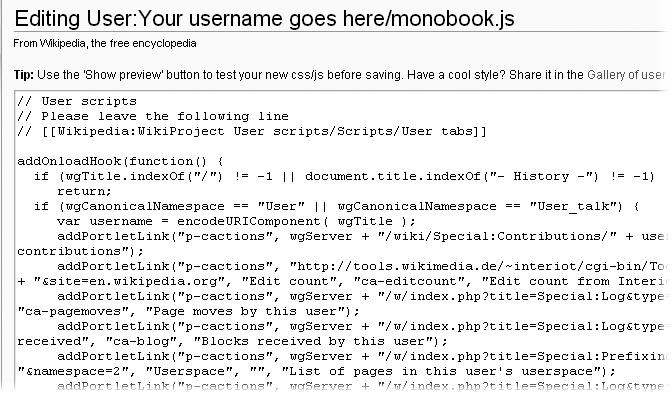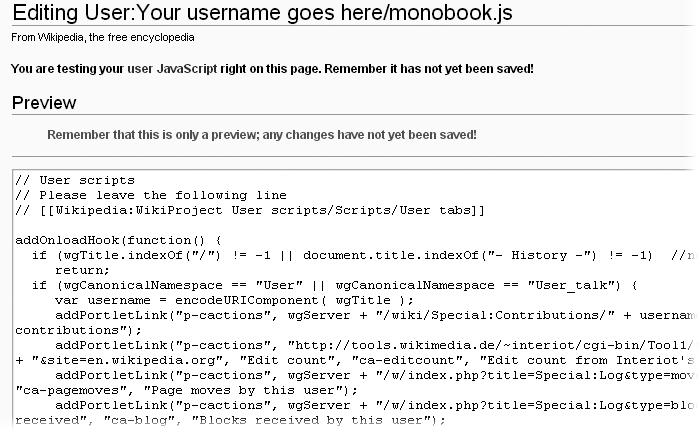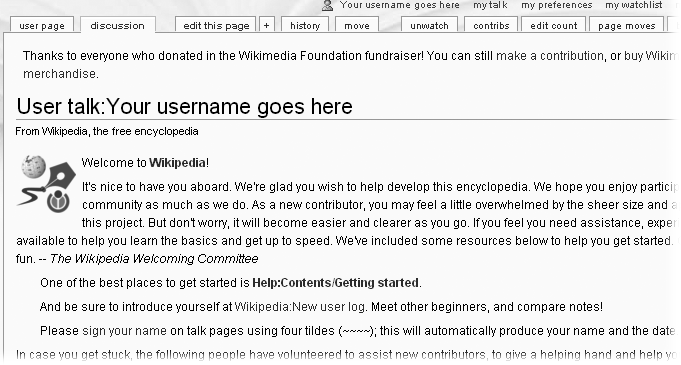To use user scripts, you create a personal JavaScript page, which only you and Wikipedia administrators can edit. On this page, you put the user scripts that you want to use, or pointers to other pages where JavaScript code is stored (which Wikipedia uses to add code to your page).
When you want to stop using a script, you edit that personal page, deleting the JavaScript code or pointer, or marking it as non-executable information. That’s called commenting it out, and it just means you’re telling the Wikipedia software not to follow those instructions.
Note
In late 2007, Wikipedia added a new feature that lets you implement user scripts with just a couple of clicks. On the My Preferences page, check the Gadgets tab to see if the script you want to add is listed on that tab. If so, you can save time by turning it on that tab, rather than following the instructions in this section. (For details, see Gadgets.)
Creating your JavaScript page is as easy as creating a subpage in your own user space, as described in Chapter 3. See Personal Subpages if you need a refresher on subpages. This chapter assumes that you’re using the standard Monobook skin for your Wikipedia window (Skin), and so you’ll name your personal page monobook.js. (If you use a different skin, see the box on Removing Scripts.)
When you’re ready to do the JavaScript jive, go to your user page, and follow these steps:
On your user page, click “edit this page”. In the edit box, type either *[[User:YourUsernameGoesHere/monobook.js]] or simply *[[/monobook.js]]. Then add an edit summary like Creating link to new monobook.js page, do a preview, and then save your edit.
You’ve just added a link to your soon-to-be-created JavaScript page. The link to the new page is red, since it doesn’t yet exist.
Click the red link to the monobook.js page, and, at the top of the edit box, add the following: // User scripts. (In JavaScript code, anything that begins with double slashes is a comment. You’ll see the “User scripts” comment, as shown in Figure 21-1.) Add an edit summary (like Creating initial page), preview the page (to reinforce the habit), and then save the page.
By saving the page with only a comment, initially, you’re creating a version of the page that you can revert to if something goes wrong. That’s extremely unlikely, but it doesn’t hurt to have the option.
Figure 21-1. All monobook.js pages have the same warning at the top – don’t copy a script just because someone else leaves a note on your user talk page about what a neato-cool tool they’ve created. (Leaving uninvited, non-personal postings on user talk pages is considered spam, and fortunately it doesn’t happen very often.) If you use JavaScript code someone else wrote, make sure it’s someone you trust.
As discussed in Chapter 7 (???), when you’re evaluating a user account to determine whether it’s a vandalism-only account, it’s helpful to look at more than the user talk page of the editor. You’ll often want to look at individual edits (the User contributions page) and the block log, for instance. This tutorial will show you how to implement some JavaScript that add tabs, making that research easier.
Go to the page Wikipedia:WikiProject User scripts/Scripts/User tabs (Figure 21-2), and copy all the text within the dotted box.
This page has no “edit this page” tab, meaning it’s protected. Don’t copy JavaScript or any other code from an unprotected page, since someone may have tampered with it.
Figure 21-2. The script at the page Wikipedia:WikiProject User scripts/Scripts/User tabs has three full lines of comment (two at the top, one at the bottom); these have two slashes at the beginning. The actual code that will be executed is the middle fifteen lines. The blanks spaces at the beginning of any line are optional—they’re there to make the script easier for humans to read. Computers don’t care one way or another. (The blank spaces at the beginnings of lines are why the text goes off-screen on the right; that’s normal for Wikipedia wikitext.)
Open your own monobook.js page, and then, in the edit box, paste the text that you copied in step 1.
If you haven’t created a monobook.js page yet, see Your Personal JavaScript Page.
Change [[User:Where/usertabs]] to [[Wikipedia:WikiProject User scripts/Scripts/User tabs]], to show where you got the script.
Your edit box should look like Figure 21-3.
Figure 21-3. In editing mode, monobook.js pages look different from regular pages. There’s no edit toolbar, because there’s no need for buttons for inserting a signature, or a table, or other text. There’s also a message about using the “Show preview” button to test the added JavaScript before saving the page.
Add an edit summary (Adding JavaScript for user tabs, for example) and then click the “Show preview” button.
The preview should look like Figure 21-4. If everything looks as you expect (as is the case here, there’s no visible change), save the page. If something looks wrong, recheck the code that you added to the page.
Figure 21-4. The nice thing about previewing a change to your personal JavaScript page is that the JavaScript is implemented immediately. If it should change the monobook.js page, you see that. In this case, the new tabs will only show on a user page, so the preview doesn’t tell you how you’re doing.
After you save the change, you should bypass your cache so that Wikipedia isn’t using an old version of your monobook.js (see ???). Then go to a page where you expect the change to appear—for example, click on the “my talk” link on the upper right, and check if the change has happened.
As shown in Figure 21-5, it indeed has.
If you still can’t see what you expect after bypassing your cache, then ask for assistance at the Help desk (shortcut: WP:HD).
Figure 21-5. Now a number of additional tabs appear whenever you go to a user or user talk page. If you decide you don’t want one or more of these, all you need to do is comment out the corresponding line on your monobook.js page (put two slashes at the very beginning), and that tab won’t appear any more.
It’s good practice to put anything other than a very short script into a separate page, with a name ending in .js, so that only you—and administrators—can edit it. That way, you don’t end up with a very long, difficult-to-understand and difficult-to-edit monobook.js page.
Suppose, for example, you put the “User tabs” JavaScript from the previous steps, into a new page called User:Your username goes here/UserTabs.js. That keeps it out of your monobook.js page, but it also means that Wikipedia doesn’t recognize it as JavaScript you actually want to use. In fact, when you go into edit mode at a new page, to paste in the code, you see a warning message (Figure 21-7) that tells you that Wikipedia can’t match the file name against any of the skins you could have chosen (see Skin), and therefore won’t automatically execute the script when you’re logged on.
Figure 21-6. When you create a page whose name ends with .js or .css, Wikipedia checks to see if that’s the name of a skin (see Skin). If not, it gives you this warning. In this case, you can ignore the warning. But if you typed (for example) MonoBook.js rather than monobook.js, earlier in the chapter, the misspelling would be critical and the warning would be relevant.
To actually use the JavaScript at your new User:Your username goes here/UserTabs.js page, you have to tell Wikipedia to import into your monobook.js page. When the Wikipedia software reads your monobook.js page, it reads the import script, and learns where to go to get the actual JavaScript. Figure 21-7 shows a bunch of import scripts on an editor’s monobook.js page.
Figure 21-7. The page User:Ais523/monobook.js has a number of JavaScript functions (user scripts) added via the importScript command, rather than pasting all the JavaScript into the page. One advantage of importScript is that you get a neat list of all your user scripts, rather than a mass of code. Separating functions by putting them on separate pages also makes it easier to share scripts with other editors.
Note
In Figure 21-7, the line second from the bottom has two slash marks in front, making the line into a comment. In geekspeak, the line is commented out, so the script won’t run. To reverse that in the future, making it functional again, just delete the slashes.
Several Wikipedia editors have created big, fabulously useful, multi-function scripts. You absolutely don’t want to cut and paste these scripts, even to a separate page of your own, because you need the editor who created it to maintain it. You want to get enhancements to the code as they occur. By using the import function, you get the benefit of those updates (as do the hundreds of other editors using the same script).
Warning
As always, don’t trust any page that isn’t protected from editing by regular editors. Don’t ever import from an unprotected page.
As you can see from reading this chapter, editing your monobook.js page is no big deal. It’s no harder than cutting and pasting text to any Wikipedia article. You can remove a function by deleting it, or by commenting it out (putting a pair of slashes at the beginning of each line). Commenting out works best for cases where you’re importing a function (see Figure 21-7) and there’s just one line to comment out. If you have 10 or 15 lines of code that you copied to your monobook.js page that you don’t want any more, the page will be a lot neater if you delete it all, perhaps leaving a single comment line about where you found the code, in case you want to copy it back in at some later point.







